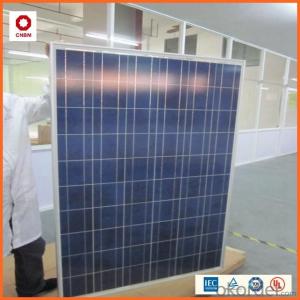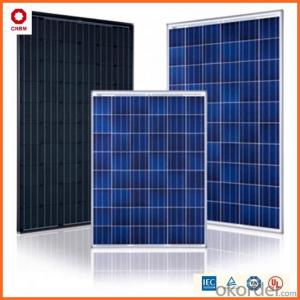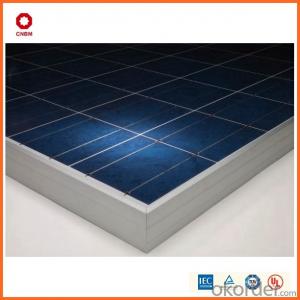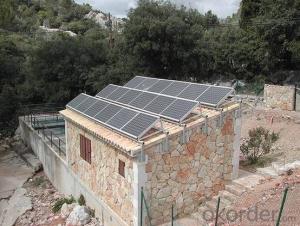45w Small Solar Panels with Good Quality
- Loading Port:
- China main port
- Payment Terms:
- TT OR LC
- Min Order Qty:
- 1 watt
- Supply Capability:
- 10000000 watt/month
OKorder Service Pledge
OKorder Financial Service
You Might Also Like
Item specifice
Hot Sale !!! Quality and Safety of Small Poly Solar Panel 25~85w
1. Rigorous quality control meets the highest international standards.
2. High-transmissivity low-iron tempered glass, strong aluminium frame.
3. Using UV-resistant silicon.
4. IS09001/14001/CE/TUV/UL
Warranties of Small Poly Solar Panel 25~85w
1. 10 years limited product warranty
2. 15 years at 90% of the minimal rated power output
3. 25 years at 80% of the minimal rated power output
Specification
Characteristics of Poly solar panels CNBM (25-85W) | |||||
Max Power Voltage Vmp(V) | 30.3 | 30.8 | 31.1 | 31.4 | 31.85 |
Max Power Current Imp(A) | 7.60 | 7.64 | 7.73 | 7.81 | 7.85 |
Open Circuit Voltage Voc(V) | 36.1 | 36.6 | 37 | 37.3 | 37.68 |
Short Circuit Current Isc(A) | 8.50 | 8.55 | 8.65 | 8.75 | 8.85 |
Max Power Pm(W) | 230W | 235W | 240W | 245W | 250W |
Temperature Coefficient of Cells Poly solar panels CNBM (25-85W) | |
NOCT | 45± 2 |
Temperature Coeffucients of Isc | 0.0492 |
Temperature Coeffucients of Voc | -0.3374 |
Temperature Coeffucients of Voc | -0.4677 |
Mechanical Data of Poly solar panels CNBM (25-85W) | |
Dimension | 1638 × 982 × 40 mm |
Weight | 19.5 kg |
No. of Cells and Connections | 60 (6 ×10) |
Tolerance | 0 ~ + 5 W |
Cell | Monocrystalline Cell 156 × 156 mm |
Packing | 624 Pcs/40ft(H) Container |
Limits of Poly solar panels CNBM (25-85W) | |
Operating Temperature | -40 to +85 |
Storage Temperature | -40 to +85 |
Max System Voltage | 1000VDC(IEC) / 600VDC(UL) |
Features of our products:
• High conversion efficiency mono/poly-crystalline amorphous silicon solar cells
• Modules incorporate high performance bypass diodes to minimize the power drop caused by shading
• High transmittance, low-iron tempered glass
• High performance EVA encapsulant to prevent destroying and water.
• AI frame: without screw, corner connection. 8 holes on the frame can be installed easily
• Good performance of preventing from atrocious weather such as wind and hails
• Certifications: CE IEC TUV VDE UL, Class I
• 10 years 90% power output warranty

Shipping of Small Poly Solar Panel 25~85w
By Sea | Delivery from Shanghai or Ningbo seaport |
By Air | Departure from Shanghai Pudong Airport |
By Express | Post by DHL, EMS, UPS, TNT. |
- Q:How does the performance of solar panels vary based on the altitude?
- The performance of solar panels varies based on the altitude due to several factors. At higher altitudes, solar panels receive more direct sunlight as there is less atmospheric interference. This can result in increased energy production. However, the temperature at higher altitudes is usually lower, which can improve the efficiency of solar panels. Additionally, lower altitudes often have more cloud cover and pollution, which can reduce the amount of sunlight reaching the solar panels and decrease their performance. Overall, while altitude can impact solar panel performance, it is important to consider other factors such as temperature, weather conditions, and geographical location for a comprehensive assessment.
- Q:Can a solar energy system be installed on a building with a flat roof?
- Yes, a solar energy system can be installed on a building with a flat roof. Flat roofs provide an ideal surface for mounting solar panels, as they offer a level surface and provide ample space for installation. Furthermore, flat roofs often have unobstructed sun exposure, which is crucial for maximizing the efficiency of solar panels.
- Q:How does the efficiency of solar panels affect a solar energy system?
- The efficiency of solar panels directly impacts the overall performance and cost-effectiveness of a solar energy system. Higher efficiency panels can generate more electricity from the same amount of sunlight, allowing the system to produce more power. This can result in a higher return on investment and shorter payback periods. Additionally, more efficient panels require less space, making them suitable for installations where space is limited. Conversely, lower efficiency panels may require more space and installation costs to achieve the desired energy output. Therefore, the efficiency of solar panels plays a crucial role in optimizing the performance and economic viability of a solar energy system.
- Q:What is the role of maximum power point tracking (MPPT) in a solar energy system?
- The role of maximum power point tracking (MPPT) in a solar energy system is to maximize the efficiency and output of the system by continuously adjusting the operating point of the solar panels to ensure they are operating at their maximum power point. This is important because the power output of solar panels is highly dependent on environmental factors such as temperature and sunlight intensity. MPPT algorithms track these variations and optimize the power output by adjusting the voltage and current to match the maximum power point. By doing so, MPPT increases the overall energy generation and improves the performance of the solar energy system.
- Q:Can solar energy systems be used in areas with high levels of wildlife activity?
- Yes, solar energy systems can be used in areas with high levels of wildlife activity. While it is true that wildlife can pose some challenges for solar energy systems, there are several ways to mitigate these issues. One of the primary concerns is the risk of damage to the solar panels by large animals or birds. However, there are various protective measures that can be taken to prevent this. For instance, installing fencing or barriers around the solar panels can help keep wildlife away. Additionally, using anti-reflective coatings on the panels can reduce the likelihood of bird collisions. Another concern is the impact of solar energy systems on wildlife habitats. It is crucial to choose the location of the solar panels carefully, considering the existing wildlife activity in the area. By conducting thorough environmental impact assessments and engaging with local wildlife experts, it is possible to minimize any potential negative effects on wildlife habitats. Moreover, solar energy systems can actually benefit wildlife in some cases. For example, solar farms can provide additional shelter and shade for some species, and the open spaces underneath the panels can create new habitats for ground-dwelling animals. Overall, while there may be some challenges, with proper planning and mitigation strategies, solar energy systems can be successfully utilized in areas with high levels of wildlife activity.
- Q:Can solar panels be installed on different types of roofs?
- Yes, solar panels can be installed on different types of roofs including flat, sloped, shingled, metal, and tile roofs. The installation process may vary depending on the roof type, but with proper mounting systems and professional installation, solar panels can be successfully installed on various roof types.
- Q:Can solar energy systems be used in areas with limited access to solar connectors and cables?
- Yes, solar energy systems can be used in areas with limited access to solar connectors and cables. Off-grid solar systems, such as standalone solar panels combined with battery storage, can be deployed in remote or inaccessible areas without the need for extensive infrastructure. These systems are self-sufficient and can generate and store electricity for use even without a direct connection to the grid. They are an excellent solution for providing renewable energy in areas where traditional electrical infrastructure is limited or non-existent.
- Q:Can solar energy systems be used in powering concert halls or auditoriums?
- Yes, solar energy systems can be used to power concert halls or auditoriums. These systems can be installed on the rooftop or nearby areas to harness sunlight and generate electricity. The generated solar power can then be used to run the lighting, sound systems, and other electrical equipment required for concerts or performances. Additionally, solar energy systems can be integrated with battery storage solutions to ensure a continuous power supply, even during periods of low sunlight or at night.
- Q:Can solar energy systems be used in powering music studios or recording studios?
- Yes, solar energy systems can definitely be used to power music studios or recording studios. Solar power systems are a clean and renewable energy source that can provide a reliable and cost-effective solution for powering various electrical equipment, including the high energy-consuming equipment found in music studios. Solar panels can be installed on the roof or any other suitable area of the studio building to harness sunlight and convert it into electricity. This electricity can then be used to power a wide range of equipment such as amplifiers, mixers, microphones, computers, lighting, and air conditioning systems. The size of the solar power system required will depend on the energy needs of the studio. By analyzing the energy consumption patterns and demands of the studio, solar energy experts can design and install a customized solar power system to meet the specific requirements of the studio. One of the advantages of using solar energy in music studios is the potential for significant cost savings. Traditional electricity sources, especially in commercial settings, can be quite expensive. By generating their own electricity through solar power, studios can reduce their reliance on the grid and potentially lower their electricity bills. Additionally, solar energy is a sustainable and environmentally friendly option. Music studios often consume a large amount of electricity, and using solar power can help reduce their carbon footprint and contribute to a greener future. It is worth noting that solar energy systems can also be combined with battery storage systems. This allows music studios to store excess energy produced during the day and use it during times of low solar generation or at night. This further enhances the reliability and independence of the solar power system. In conclusion, solar energy systems can be effectively used to power music studios or recording studios. They offer a clean, renewable, and cost-effective solution that can meet the energy demands of these facilities while reducing their environmental impact.
- Q:What is the impact of temperature on solar energy system performance?
- Temperature can have a significant impact on solar energy system performance. As the temperature increases, the efficiency of solar panels tends to decrease. This is because higher temperatures can cause the panels to operate at a higher voltage, resulting in a drop in overall efficiency. Additionally, excessive heat can also lead to a decrease in the lifespan of solar panels. However, it is worth noting that cold temperatures can actually benefit solar panels, as they tend to increase their efficiency. Therefore, temperature variations need to be carefully considered when designing and maintaining solar energy systems for optimal performance.
1. Manufacturer Overview |
|
|---|---|
| Location | |
| Year Established | |
| Annual Output Value | |
| Main Markets | |
| Company Certifications | |
2. Manufacturer Certificates |
|
|---|---|
| a) Certification Name | |
| Range | |
| Reference | |
| Validity Period | |
3. Manufacturer Capability |
|
|---|---|
| a)Trade Capacity | |
| Nearest Port | |
| Export Percentage | |
| No.of Employees in Trade Department | |
| Language Spoken: | |
| b)Factory Information | |
| Factory Size: | |
| No. of Production Lines | |
| Contract Manufacturing | |
| Product Price Range | |
Send your message to us
45w Small Solar Panels with Good Quality
- Loading Port:
- China main port
- Payment Terms:
- TT OR LC
- Min Order Qty:
- 1 watt
- Supply Capability:
- 10000000 watt/month
OKorder Service Pledge
OKorder Financial Service
Similar products
New products
Hot products
Hot Searches
Related keywords































